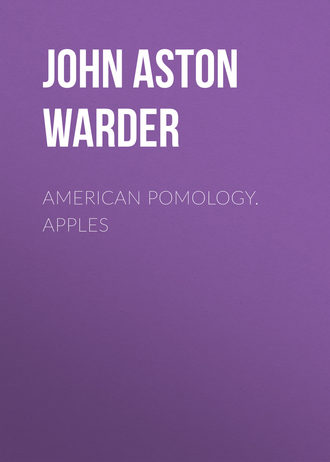 полная версия
полная версияПолная версия
American Pomology. Apples
This variety is much like the Minkler, which originated in Illinois, and both may have come from seeds of the Gilpin, which they resemble.
Tree vigorous and productive.
Fruit medium, oblate, regular; Surface smooth, yellow, covered with mixed red and striped bright red; Dots scattered, minute.
Basin medium, folded or plaited; Eye large, closed.
Cavity wide, regular, green; Stem short or medium.
Core flattened, closed, clasping the eye; Seeds numerous, plump, dark; Flesh greenish-yellow, firm, breaking; Flavor sub-acid; Quality scarcely second rate, but useful for cooking, and keeps sound until May.
Carolina BaldwinThis nice southern apple was received from S.W. Westbrooke, of Greensboro'. Of the tree I know nothing.
Fruit medium, oblate, regular; Surface yellow-green, with mixed red and stripes; Dots numerous, large, white.
Basin abrupt, regular; Eye large, closed.
Cavity wide, regular; Stem, medium to long.
Core small, regular, heart-shaped, closed; Seeds pointed; Flesh yellow, fine-grained, juicy; Flavor, sub-acid; good for table in November.
CheeseThis fruit was received from Lewis Sanders, of Grass Hills, Gallatin County, Kentucky, by whom it was grown and esteemed.
Fruit medium to small, oblate, regular; Surface smooth, yellowish-green, striped purple red, splashed deep red; dots scattered, gray and purple.
Basin shallow, regular, or abrupt and deep, in different specimens; Eye small, closed.
Cavity wide, regular, brown; Stem long, slender.
Core regular, closed; Axis long; Seeds plump, pointed, dark; Flesh yellow, tender, fine-grained, juicy; Flavor sub-acid, agreeable; Quality good for the table in December and January.
ColvertFruit large, roundish-oblate, slightly conic, regular, often unequal; Surface smooth, yellowish-green, mixed, striped, light red; Dots scattered, distinct, white.
Basin deep, abrupt, regular, folded; Eye medium.
Cavity rather deep, acute, brown; Stem medium.
Core round, flattened, slightly open, meeting the eye; Seeds numerous, long, pointed, imperfect; Flesh white, breaking, fine-grained, juicy; Flavor sub-acid; Quality scarcely good; Use, market chiefly; Season October, November.
Cooper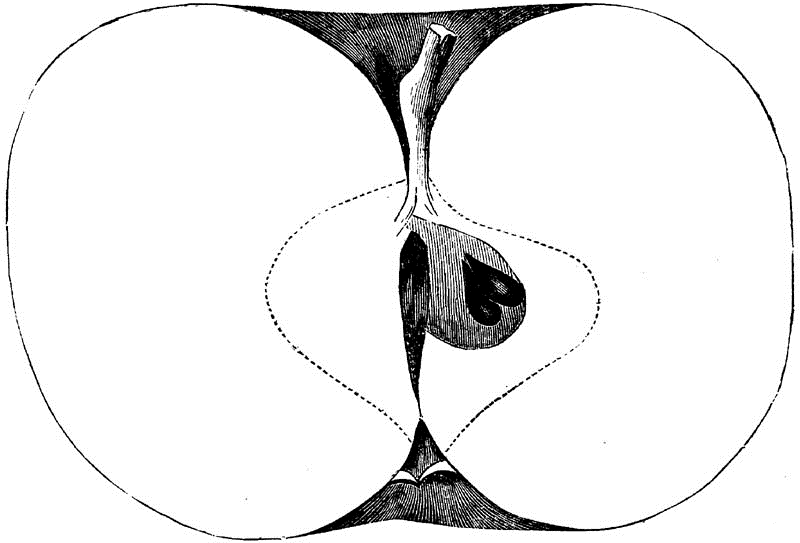
Fig. 87.—COOPER.
This delicious apple was introduced into the West with the scions that were brought to the early Putnam nursery at the mouth of the Muskingum river in 1796. Though a general favorite from its beauty, its fine texture, and exquisite flavor, this variety does not appear to have been so widely spread as others very inferior to it. Though occurring on the original Putnam list, and therefore an eastern variety, it does not appear to have been recognized by cultivators in the older States, and there are those in the West who claim that it is of French origin.
The tree has a stout, upright growth, which becomes spreading with age, when the limbs stand at a right angle with the trunk; they are frequently defaced with marks of diseased action that are called canker. The twigs are reddish and rather slender; the leaves are pale green, large, broad.
Fruit large, globular-oblate, regular, sometimes unequal, light; Surface smooth, pale waxen-yellow, with a little mixed scarlet and very distinctly marked carmine; Dots scattered, minute.
Basin regular, abrupt, deep; Eye small, closed.
Cavity wide, regular, green; Stem medium, green.
Core small, closed, just meeting the eye; Seeds numerous, plump, short, dark; Flesh pale yellow, fine-grained, tender, almost melting, juicy; very mild sub-acid, aromatic; of first quality for table, kitchen or market (too good for drying, but makes a superior article of snits); Season September and October.
Dr. WatsonAUTUMN SEEK-NO-FURTHER OF INDIANA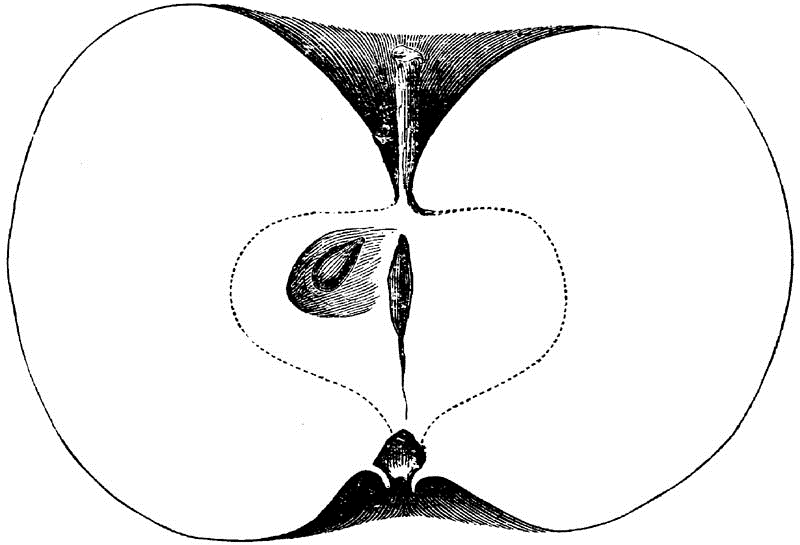
Fig. 88.—DR. WATSON.
This delicious and beautiful dessert apple is much grown in Central and Eastern Indiana, particularly among the Friends. It was for a long time a puzzle to the pomologists. In the meanwhile it must have a name, and without waiting for the decision of the learned, the people in different sections, without consultation, called it the Autumn Seek-no-further. Finally the Horticultural Societies decided that it was an old sort named Doctor Watson, though upon what authority does not appear. The fruit has not been recognized by our Eastern friends, nor by the American Pomological Society, to which it was referred in 1860.
Tree large, spreading, very productive; Twigs slender, foliage small, pale green; in the nursery it is a poor grower.
Fruit medium to large, unless when too crowded, regular, oblate, sometimes unequal; Surface smooth, mixed pale and red on waxen-yellow, beautifully splashed with scarlet; Dots minute.
Basin abrupt, rather deep, wide, regular, sometimes cracked; Eye medium, open.
Cavity wide, regular or wavy, brown; Stem medium to short.
Core medium, regular, closed, just meeting the eye; Axis short; Seeds plump; Flesh yellow, fine-grained, very tender and juicy, almost melting, with a rich, aromatic, sub-acid flavor; Quality best, for table and kitchen, from September to November; also valuable for stock feeding.
Domine
Fig. 89.—DOMINE.
Supposed to be a native of this country; origin unknown. Tree very thrifty, making long, stout, brown shoots, which branch from the ends, and form spurs along their sides, so that the tree has a straggling, open head, and bears its fruit crowded along the smaller branches. It is hardy, upright, vigorous and productive. Foliage large and long, with a peculiar curl or folding upwards, so as to show the underside of the leaves.
Fruit large, flat, regular, sometimes unequal; Surface yellowish-green, nearly covered with mixed red, and striped indistinctly with carmine, often vein-russeted; Dots scattered, yellow and gray, large.
Basin rather shallow, folded or plaited; Eye medium to small, closed.
Cavity wide, wavy, brown; Stem medium to long, slender at its insertion into the fruit, and easily separated from it, but holding firmly to the tree; hence care is needed in picking the fruit.
Core regular, somewhat open, scarcely meeting the eye; Axis often short; Seeds numerous, pointed, plump; Flesh light yellow, breaking, tender, juicy; flavor slightly sub-acid, rich; good, for table, kitchen, or market; Season December and January, keeping until spring in the North.
Duchess of OldenburghThis very beautiful striped apple is from Russia, and has proved one of the hardiest apples in our trying climate. Reports from the Northwest are entirely satisfactory as to its hardiness.
Tree medium size, round-headed, sufficiently vigorous and perfectly hardy.
Fruit medium, regular, roundish-oblate; Surface smooth, waxen-yellow, partially covered with distinct and regular stripes and splashes of brilliant red and carmine; often having a light bloom, such as is found on most Russian apples.
Basin regular, pretty wide; Eye large and closed.
Cavity regular, acute; Stem medium to long, rather slender.
Flesh white, tender, juicy; Sour and suitable for cooking. Though attractive to the eye, it is unsuited for the dessert.
By Dr. Jno. A. Kennicott, the pioneer cultivator of Northern Illinois, this apple was considered the ne plus ultra for that and higher latitudes.
EquineteleeBACHELOR—BYERS—IOLA (Berckmans' M.S.) SOL. CARTEE (Downing.)
Fig. 90.—EQUINETELEE.
This fine southern apple has its origin traced to Yancey County, in North Carolina. It has not yet been sufficiently tested in the Northern States, but is considered one of the best in the South, and is looked upon as having great promise in our northern orchards, where it is somewhat introduced. Berckmans says: "The finest of the late fall and winter apples."
The trees bear a strong resemblance to those of the Buckingham.
Fruit large, oblate, sometimes oblique; Surface light yellow, mostly covered with bright crimson, obscurely striped; Dots small, white.
Basin deep, narrow, irregular; Eye medium, closed.
Cavity wide, deep; Stem short.
Flesh pale yellow, very tender, juicy, melting; Flavor very mild sub-acid, making it a very superior table fruit, from November to January in Georgia, according to Berkmans.
Evening Party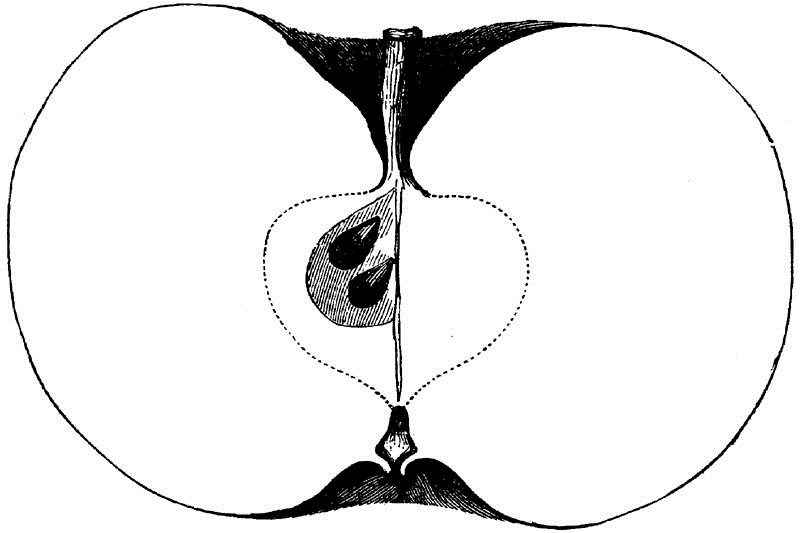
Fig. 91.—EVENING PARTY.
This excellent dessert fruit originated in Berks County, Pennsylvania, and was brought into notice by the late lamented Dr. Brinkle, of Philadelphia, in his ad-interim reports, and also in Hoffy's Fruits. It has been tested with entire satisfaction by J.D.G. Nelson, President of the Indiana Horticultural Society, who always has admirers of the fruit exhibited by him at the winter meetings. This apple takes the place at mid-winter which is occupied in summer by the Early Joe, and in autumn by the Jefferies, Dr. Watson and Cooper.
Fruit medium to small, regular, quite flat; Surface smooth, mixed red, and carmine stripes on waxen-yellow ground; Dots numerous, distinct, gray.
Basin abrupt, regular deep; Eye small, closed; Segments long.
Cavity wide, deep, regular, brown; Stem medium, green, slender.
Core small, regular, closed, touching the eye; Axis short; Seeds short, wide, dark; Flesh light yellow, very fine-grained, tender, juicy; Flavor sub-acid, aromatic; first quality, or very best, for the dessert, or the evening party, during December and January.
Fall Wine
Fig. 92.—FALL WINE.
Origin unknown. A great favorite in the West as a table fruit; little grown in the Eastern States, whence it was brought. Downing supposes this is because the fruit is there defective. In virgin soil it is remarkably fair and handsome.
Tree of medium size, rather slender, but healthy, spreading, and annually productive.
Fruit medium, oblate, handsome; inclined to crack open if left on the tree till ripe; Surface very smooth, waxen-yellow, almost completely covered with bright, and often deep red, upon which it is indistinctly striped; Dots minute.
Basin abrupt, wide, regular or wavy; eye small, closed; Calyx reflexed.
Cavity wide, regular, uniformly green; Stem long, slender.
Core medium, regular, closed, meeting the eye; Seeds numerous, angular or plump; flesh yellow, breaking, tender, fine-grained, juicy; flavor mild sub-acid, and very aromatic; Quality best, for table and market, during September and October or later.
GardenGARDEN ROYAL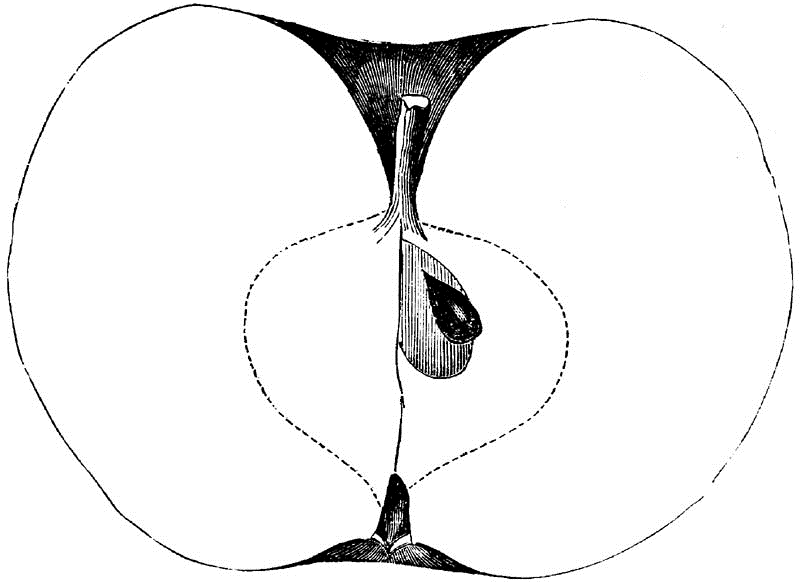
Fig. 93.—GARDEN.
This fine apple has been received from quite distant points, Chillicothe, Ohio, and Salem, Indiana. It is quite distinct in season from the Beefsteak or Garden of Downing, but in description corresponds very closely with the Garden-Royal of Elliott, which fruit I have not seen. Origin unknown.
Fruit pretty large, roundish, flat, regular; Surface smooth, yellowish-green, slightly shaded red, scattered stripes, carmine; Dots minute, black.
Basin wide, regular, small, closed.
Cavity deep, acute, regular, green; stem short to medium, sometimes knobby.
Core wide, closed or open, regular, clasping the eye; seeds small, pointed, brown; flesh pale yellow or whitish, tender, fine-grained, juicy; Flavor sub-acid, aromatic, saccharine, agreeable; Quality very good to best; Use dessert, kitchen, market; Season August to October; worthy of cultivation.
GolayThis fruit originated near Vevay, Indiana, and is supposed to be a seedling of the Janet, which it somewhat resembles.
Fruit medium, oblate, somewhat conic, truncated, regular; Surface smooth, yellow, mixed, striped, purplish-red; Dots minute, gray, scattered, indented.
Basin wide, regular; Eye small, closed.
Cavity wide, regular; Stem short.
Core very small, pyriform, closed, clasping; Seeds numerous, large, plump, brown; Flesh yellowish-white, breaking, tender, juicy; Flavor sub-acid, rich; Quality good to best; Use, table; Season, January to May.
Harvest RedstreakThis old variety is valued only as an early cooking apple, for which it has been found very profitable, by those who attend market. Origin unknown. Introduced into the West by Silas Wharton, from the neighborhood of Philadelphia, where it was cultivated largely. Not recognized among the varieties described by Coxe.
Tree spreading, open, round-headed; Twigs stout; Leaves small, mealy.
Fruit medium, roundish-oblate, regular; Surface smooth, greenish-yellow, striped and splashed with red, more or less mingled; Dots minute, dark, and a light bloom.
Basin medium, folded; Eye medium, closed.
Cavity acute, regular, often brown; Stem medium, thick.
Core regular, closed; Seeds angular; Flesh whitish, breaking, coarse, juicy, becoming dry; Quality inferior, except for cooking; Season July.
High-Top.—[LEWIS JONES.]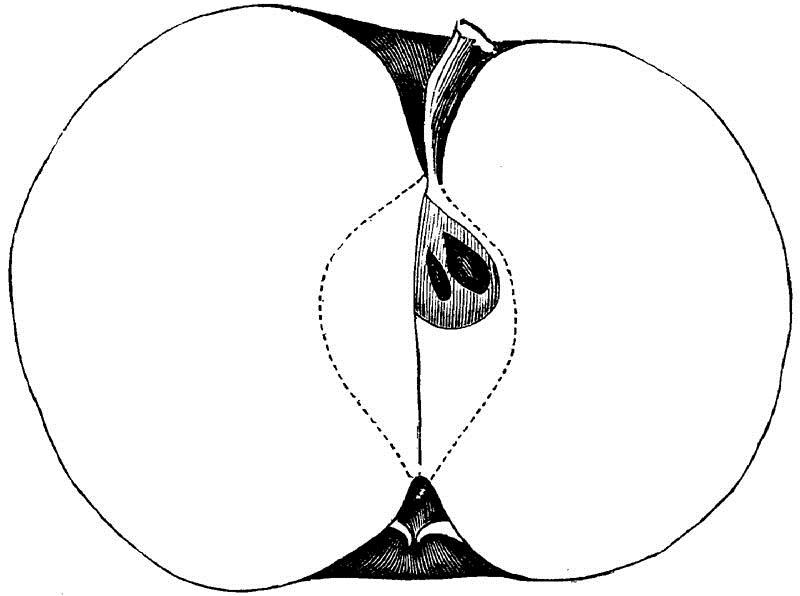
Fig. 94.—HIGH-TOP.
This handsome apple is supposed to have originated in Wayne County, Indiana, and was brought into notice by Lewis Jones.
Fruit large, flat, roundish, regular; Surface smooth, mixed dull red, striped carmine; Dots scattered, minute.
Basin wide, medium, folded; Eye medium, closed.
Cavity wavy, brown, acute; Stem short, green.
Core regular, closed, or wide and open, clasping; Seeds numerous, short, plump, pale; Flesh pale yellow, fine-grained, tender, juicy; Flavor sub-acid, aromatic; Quality good to very good; Use table, kitchen, market; Season, December, January; reminds one somewhat of Domine.
HockingThis variety has only been found in western orchards, and has not been mentioned by name in any fruit book with which I have met. At the second meeting of the Northwestern Fruit Growers' Convention, it was reported as having been brought from Fairfield County, Ohio; its resemblance to Townsend was also observed, but it was declared to be different in wood and buds. These apples may yet prove to be identical, but as the question is not settled, both will be described.
Tree thrifty, vigorous, productive—an early bearer.
Fruit medium to large, globular-oblate, regular; Surface smooth, yellow, covered with mixed red, and splashed carmine; Dots minute, yellow.
Basin medium, regular; Eye medium to large, closed.
Cavity medium, regular, green; Stem medium to long.
Core small, closed; Seeds large, brown; Flesh light yellow, breaking, juicy; Sub-acid; Quality good; Market and kitchen; September.
HuntAnother of Lewis Jones' apples, supposed to be a seedling of Eastern Indiana; productive.
Fruit medium, roundish-oblate, regular; Surface smooth, yellow, mixed, striped bright red; Dots numerous, yellow.
Basin rather wide, abrupt, folded; Eye small, closed.
Cavity wide, regular; Stem medium, slender.
Core small, roundish, flattened, closed, not meeting the eye; Seeds numerous, angular; Flesh yellow, breaking, fine-grained, juicy; flavor sub-acid, aromatic; Quality good to very good; Use table, market; Season December and January.
Indiana Favorite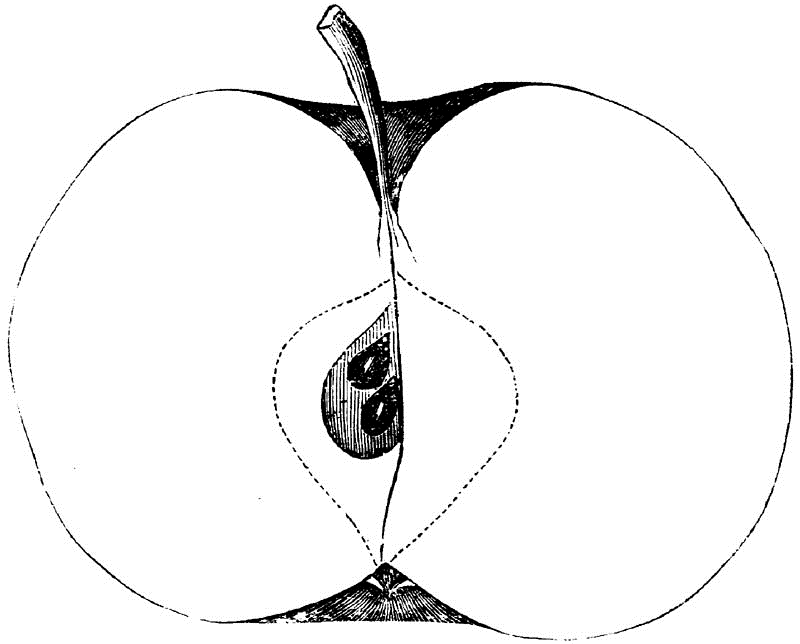
Fig. 95.—INDIANA FAVORITE.
This fruit resembles the Pennsylvania Vandervere, from which it may have sprung. Origin believed to be Fayette County, Indiana. It is considerably cultivated in the eastern part of the State, where I procured specimens exhibited at the Richmond Horticultural Society.
Tree vigorous, spreading, productive.
Fruit medium, globular-oblate, regular; Surface very smooth, bright red, striped with darker red; Dots numerous, star-shaped, yellow.
Basin wide, regular, abrupt; Eye small, closed.
Cavity acute, regular, green or brown; Stem medium to long, red.
Core regular, closed, clasping the eye; Seeds numerous, angular, imperfect; Flesh pale yellow, breaking, fine-grained, juicy; Mild sub-acid; Good to very good, for table and market, from January to March.
Jarminite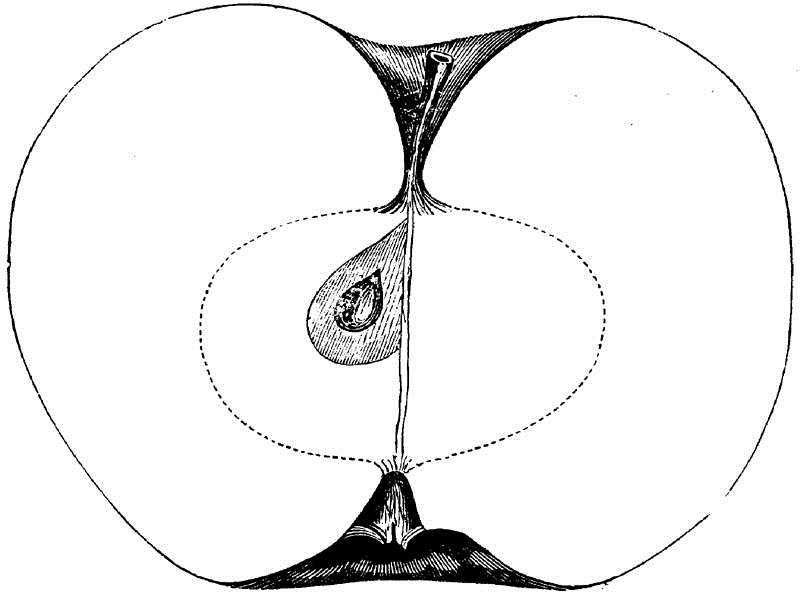
Fig. 96.—JARMINITE.
This new fruit originated on the farm of Jarmin Ballard, in Highland County, Ohio, where it was grown from the seed of Gilpin.
The tree is very vigorous, and only too productive.
Fruit medium, regular, oblate, or roundish; Surface smooth, green, partially covered with mixed and striped dull red.
Basin regular, wide; Eye medium, closed.
Cavity regular, acute; Stem slender, medium to short.
Core regular, closed, clasping; Seeds few, large, dark; flesh breaking, firm; Mild sub-acid, almost sweet; December until March.
Jefferies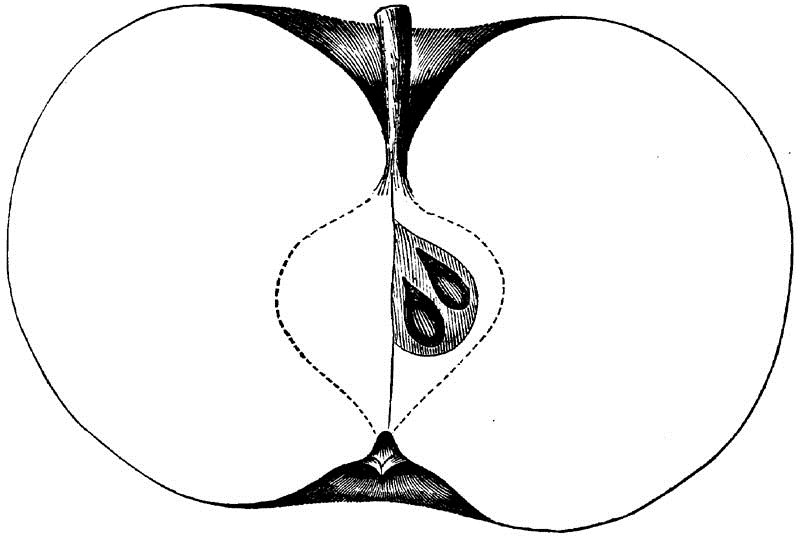
Fig. 97.—JEFFERIES.
This delicious autumn apple originated in Chester County, Pennsylvania, and was first described by the ad-interim committee of the Pennsylvania Horticultural Society; also in the Farm Journal, for 1853, by David Townsend, of Westchester, Pa.
Tree healthy, sufficiently vigorous, shoots slender, foliage bright green; productive, early bearer.
Fruit full medium, oblate, regular; Surface smooth, yellow, mixed and splashed crimson; Dots large, scattered, yellow.
Basin wide, regular; Eye small, closed.
Cavity medium, regular, brown; Stem medium to long.
Core small, closed, regular, clasping; Seeds numerous, large, brown; Flesh yellow, breaking, fine-grained, juicy; flavor sub-acid, aromatic, delicious; Quality very good, for table and market, during August, September and October.
Kentucky King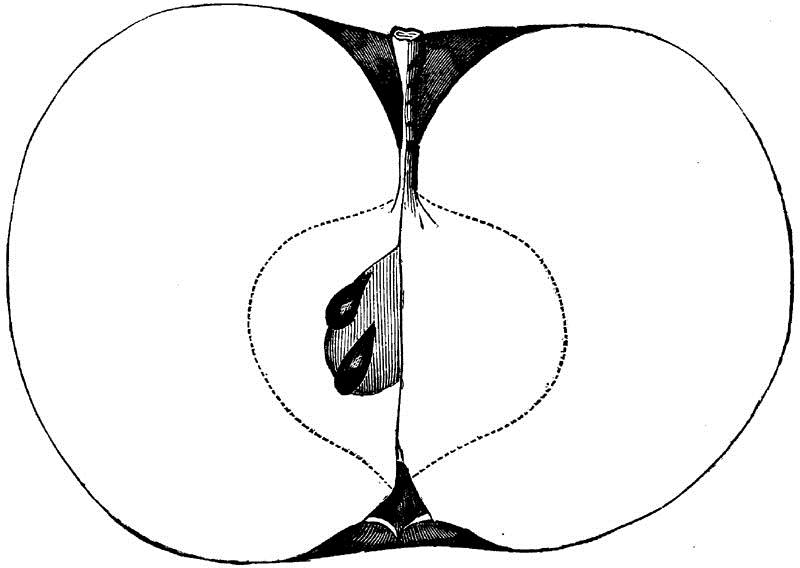
Fig. 98.—KENTUCKY KING.
Received from J.S. Downer & Son, Elkton, Kentucky. Further history not known.
Fruit above medium, flat, regular; Surface smooth, yellow, with mixed and striped carmine; Dots scattered, minute.
Basin medium, regular; Eye medium, open.
Cavity medium, regular, brown and green; Stem medium to long.
Core medium, round, closed, clasping; Seeds numerous, angular, pointed, dark; Flesh yellow, breaking, fine-grained, juicy; Flavor sub-acid, aromatic; Quality good to very good; Use table, kitchen; Season December, February.
Klaproth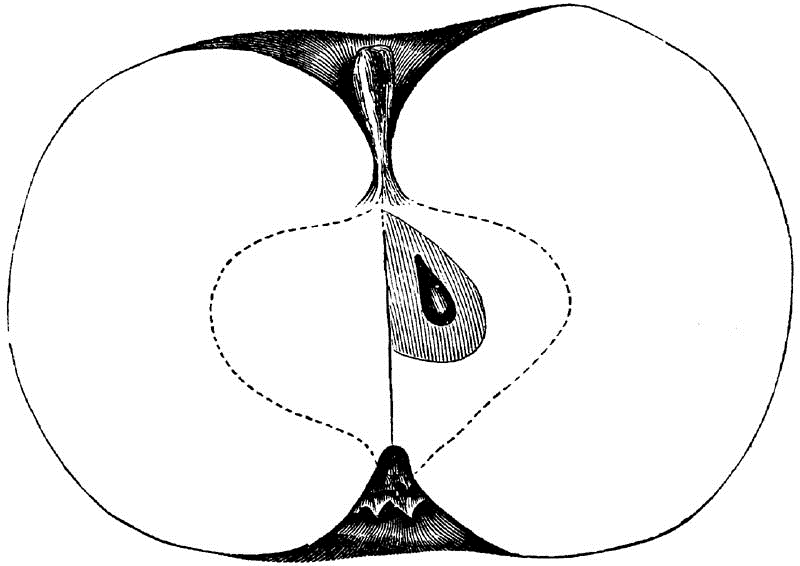
Fig. 99.—KLAPROTH.
Another Pennsylvania apple, introduced by my friend Dr. J.K. Eshleman. Tree vigorous, large, productive.
Fruit medium, regular, oblate; Surface dull yellow, more or less covered with red stripes; Dots numerous, light.
Basin wide, regular; Eye closed, small; Calyx reflexed.
Cavity deep, regular, brown; Stem short to medium.
Flesh white, breaking, tender, very juicy; Flavor acid, to sub-acid when ripe; Good; August till October.
Lewis.—Of RaganOriginated in Putnam County, Indiana, as one of the many seedlings produced by my old friend Reuben Ragan.
Tree thrifty and productive.
Fruit medium, regular, oblate; Surface smooth, deep red on yellow; Dots, numerous, large, yellow.
Basin medium, regular, not deep; Eye small, closed
Cavity wide, regular, brown; Stem short.
Core wide, regular, closed, meeting the eye; seeds numerous, plump; Flesh yellow, tender, fine-grained, juicy; flavor sub-acid, aromatic; Quality nearly first-rate for table; Season, October.
LackerThis old Pennsylvania apple is cultivated to some extent in the Western States for its beauty. Specimens from Henry Myers, South Bend, Indiana, from his beautiful collections shown at the State Fairs.
Fruit full medium to large, very handsome, oblate, regular; Surface smooth, highly polished, bright red on pale yellow, striped dark red; Dots numerous, pale.
Basin wide, wavy; Eye small, closed; Segments short.
Cavity deep, narrow, wavy; Stem short to medium.
Core small, roundish or oval, closed, clasping; Seeds numerous, plump; Flesh whitish, breaking, fine-grained, juicy; Flavor mild sub-acid, aromatic, fine; Quality good; use table, market; Season January to March.
McDanielThis is a seedling of Green County, Ohio, to which was awarded a premium at the State Fair in 1855.
Fruit full medium, regular, oblate; surface very smooth, yellow, well covered with rich, crimson, indistinct stripes; dots scattered, light gray.
Basin medium, regular; eye medium, closed.
Cavity narrow, regular; stem short.
Core medium, regular, closed; seeds plump, dark; flesh rich yellow, solid, juicy; flavor sub-acid, rich, piquant, like a Spitzenberg; October, November.
Minkler
Fig. 100.—MINKLER.
Produced by S.G. Minkler, of Kendall, Illinois.
This variety very closely resembles that described as Buchanan, though their origin is entirely distinct. The Minkler also bears a very close resemblance to an apple found at Quincy, Illinois, and known as the Brandywine.
Tree very thrifty, spreading, branches strong, forming a large angle with the stem.
Fruit medium to large, regular, globular-ovate; Surface smooth, greenish-yellow, covered with mixed red, and stripes of dark dull red; Dots scattered, minute, yellow.
Basin wide, shallow, regular; Eye small, closed.
Cavity acute, rather deep, brown; Stem medium.
Core large, closed, meeting the eye; Seeds numerous, long, pointed; Flesh yellow, or greenish-yellow, fine-grained, breaking, juicy; Sub-acid; Second quality; Use market and cooking; from March until May.
Newtown Spitzenberg.—[COXE.]VANDERVERE, OF NEW YORK (Downing)—OX-EYE—JOE BERRY, ETCOrigin, Newtown, Long Island.
Tree sufficiently vigorous, not of the largest size, spreading, compact, round head, foliage rather small, curled, showing the whitish underside. Productive.
Fruit medium to large, regular, globular-oblate, often inclined or lop-sided when overgrown in young orchards, apt to be scabby and defective on old trees, and falls badly; Surface smooth, deep red, mixed and striped, on rich yellow ground, often over-spread with whitish, giving the fruit a gray appearance; Dots numerous, minute, fawn color on dark specimens.
Basin medium, regular; Eye small, closed.
Cavity regular, medium, brown; Stem short.
Core regular, wide, somewhat open, meeting and sometimes clasping the eye; Seeds numerous, angular; Flesh rich, yellow, very fine-grained, very tender, juicy; Flavor rich sub-acid and saccharine, aromatic, eminently satisfying; Quality best, for table and kitchen, in December.
NickajackSUMMEROUR—JACKSON RED—BIG HILL—CAROLINA, AND MANY OTHERS.48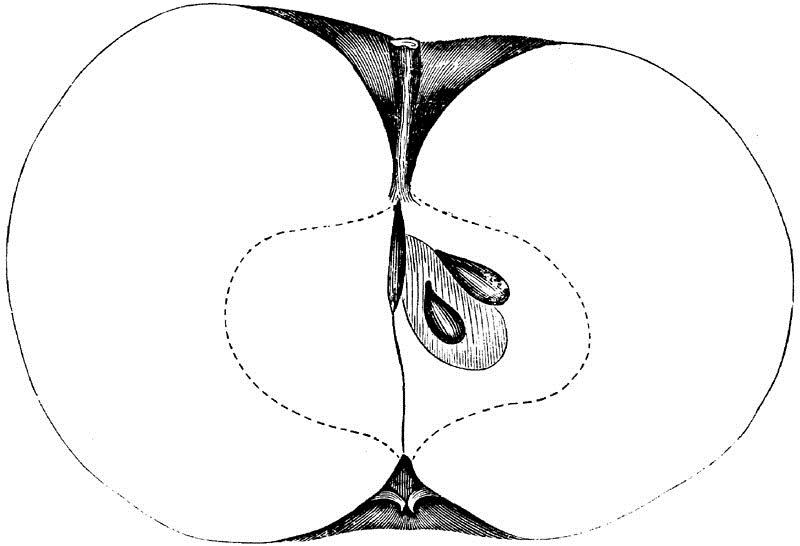
Fig. 101.—NICKAJACK.
This southern apple, which has extended more widely northward than most of its congeners, is believed to be a native of Macon County, Georgia.
Tree robust, spreading, large, very productive, young shoots stout and red.
The following description is that of a specimen sent by my friend, R. Peters, of Atlanta, Georgia, but it corresponds in all important particulars with those of fruits obtained from a dozen different sources in our own latitude:
Fruit large, globular-oblate, regular, not handsome; surface even but not smooth, mostly covered with mixed brick-dust red, striped indistinctly with dark red, some stripes very distinct; dots scattered, yellow.
Basin shallow, regular, even; eye small, closed.
Cavity acute, regular, yellow and brown; Stem medium slender.



